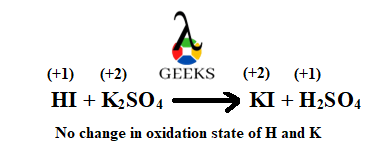Inorganic reactions specifically have a definite relation with changing temperature and pressure conditions. Let us study the chemical reactivity of HI and K2SO4.
HI works as a reducing agent in organic synthesis for conversion of aromatic nitro compounds into aniline derivatives. The usage in Cativa process as co catalyst is in high demand for the preparation of acetic acid using methanol. K2SO4 is an inorganic compound made of a combination of acid salt and alkaline salt.
The reactivity of HI and K2SO4 can be a source of various important compounds utilized as fertilizers and agricultural markets. Thus, these important reaction based mechanisms are explored in detail:
What is the product of HI and K2SO4?
HI and K2SO4 interact to produce potassium iodide (KI) and sulphuric acid (H2SO4). The complete chemical equation is given as:
HI + K2SO4 = KI + H2SO4
What type of reaction is HI + K2SO4?
HI + K2SO4 is a substitution reaction where hydrogen and potassium cation gets substituted amongst each other to form new compounds namely KI and H2SO4.
How to balance HI + K2SO4?
The following algebraic methodology can be used as an explanation to balance the chemical reaction
HI + K2SO4 = KI + H2SO4,
- Label each species (reactant or product) given in the chemical equation with a respective variable (A, B, C, and D) to illustrate unknown coefficients.
- A HI + B K2SO4 = C H2SO4 + D KI
- Deduce a suitable equation for each element in the reacting species representing the number of atoms of an element in each reactant or product species, applied to solve the equation.
- H = A = 2C, I = A = D, K = 2B = D, S = B = C, O = 4B = 4C
- The Gaussian elimination and substitution methodology is applied to simplify all the variables and coefficients, and the outcomes are
- A = 2, B = 1, C = 1, and D = 2
- Hence, the overall balanced equation is,
- 2 HI + K2SO4 = 2 KI + H2SO4
HI + K2SO4 titration
HI + K2SO4 system cannot be utilized for titration as K2SO4 does not provide a significant reaction towards the indicators used in the titration.
HI + K2SO4 net ionic equation
The net ionic equation of HI + K2SO4 is
2K+ (aq) + SO4-2 (aq) + 2H+ (aq) + 2Cl– (aq) = 2K+ (aq) + 2Cl– (aq) + 2H+ (aq) + SO4-2 (aq)
The net ionic equation is deduced as per the following steps
- Write the balanced chemical equation and designate the physical states of reactants and products accordingly
- 2 HI (aq) + K2SO4 (aq) = 2 KI (aq) + H2SO4 (aq)
- Now, strong acids, bases, and salts dissociate into ions whereas pure solid substances and molecules do not dissociate
- Thus, the net ionic equation is
- 2K+ (aq) + SO4-2 (aq) + 2H+ (aq) + 2Cl– (aq) = 2K+ (aq) + 2Cl– (aq) + 2H+ (aq) + SO4-2 (aq)
- Furthermore, the net ionic equation is made up of the species that were involved in the reaction. As all the ions were spectator ions in the given reaction thus, net ionic equation becomes ambiguous.
HI + K2SO4 conjugate pairs
- The conjugate base of the strong acid HI is I–.
- K2SO4 is a weak base so it forms a conjugate acid HSO4-2 by accepting a proton.
HI + K2SO4 intermolecular forces
Intermolecular forces acting on HI and K2SO4 are:
- HI is observed to interact via strong hydrogen bonding, weak London dispersion forces, and dipole-dipole interactions among the molecules.
- K2SO4 being an ionic compound interacts via ionic interaction forces forming ion-dipole intermolecular bonding between K+ and SO4-2 ions.
HI + K2SO4 reaction enthalpy
HI + K2SO4 exhibits a positive reaction enthalpy of +245.01 kJ/mol. The reaction enthalpy is calculated using the following formula:
ΔH⁰f (reaction) = Σ ΔH⁰f (products) – Σ ΔH⁰f (reactants)
Enthalpy information for the reactants and products involved are as follows:
- Enthalpy of formation for reactant HI: +25.95 kJ/mol
- Enthalpy of formation for reactant K2SO4: -1413.0 kJ/mol
- Enthalpy of formation for product H2SO4: -814.4 kJ/mol
- Enthalpy of formation for product KI: -327.64 kJ/mol
Is HI + K2SO4 a buffer solution?
HI + K2SO4 cannot work as a buffer solution as the buffer is prepared by the addition of weak acid into the salt of the conjugate base whereas HI is not a weak acid and K2SO4 is not a salt of the conjugate base of HI.
Is HI + K2SO4 a complete reaction?
HI + K2SO4 is a complete reaction because KI and H2SO4 formed in the reaction are the stable products.
Is HI + K2SO4 an exothermic or endothermic reaction?
HI + K2SO4 is an endothermic reaction because the calculated reaction enthalpy is observed to be positive which means heat is absorbed in the process to complete the reaction.
Is HI + K2SO4 a redox reaction?
HI + K2SO4 is not a redox reaction because hydrogen and potassium do not change and remain at +1 and + 2 oxidation state respectively at both sides of the reactant and product in the required reaction.

Is HI + K2SO4 a precipitation reaction?
HI + K2SO4 is not a precipitation reaction as KI and H2SO4 produced in the reaction are highly soluble in water leaving no precipitate to develop in reaction.
Is HI + K2SO4 reversible or irreversible reaction?
HI + K2SO4 is an irreversible reaction because the products formed in the reaction do not convert themselves back into the original reactants until the conditions are kept the same.
Is HI + K2SO4 displacement reaction?
HI + K2SO4 is a displacement reaction because the hydrogen cation is displaced by the potassium cation to form the new ionic compound KI in the process.
Conclusions
The chemical reactivity of HI + K2SO4 forms potassium iodide and sulphuric acid as the important compounds. Both the compounds are significantly important chemicals of organic chemistry. KI is of extreme utility in the salt iodization processes.

Hi…..This is Avneesh Rawat, I have done my Ph.D. in Chemistry from Govind Ballabh Pant University of Agriculture and Technology. Currently, I am working as Project Associate in CSIR, CIMAP, Pantnagar. I am specializing in handling sophisticated GC/MS, GC, HPLC, FTIR instrumentation.